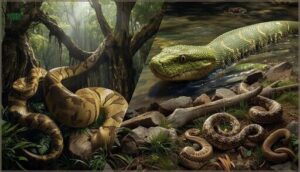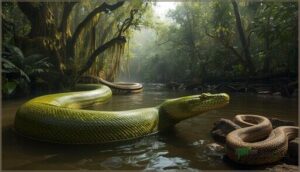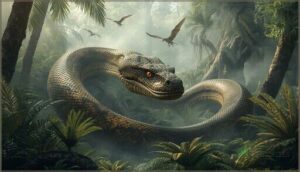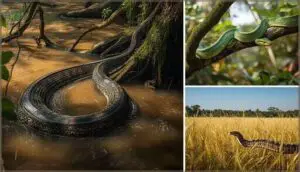This site is supported by our readers. We may earn a commission, at no cost to you, if you purchase through links.
A Titanoboa cerrejonensis stretched 13 meters long and weighed over a ton—imagine a snake the length of a school bus, thick as a barrel, capable of swallowing a crocodile whole. This prehistoric behemoth, discovered in Colombian coal mines, reigned 60 million years ago when Earth’s climate ran hotter and wetter, allowing cold-blooded giants to reach proportions that would terrify modern observers.
While nothing alive today matches Titanoboa’s sheer mass, you’d be stunned by the living leviathans still prowling tropical rivers, rainforests, and swamps across the globe. Reticulated pythons exceed 6.95 meters in authenticated measurements, green anacondas tip scales at 227 kilograms, and several other species routinely grow large enough to overpower deer, wild pigs, and even jaguars.
From the dense jungles of Southeast Asia to the flooded grasslands of South America, these dominant constrictors command their ecosystems with raw power, stealth, and evolutionary adaptations perfected across millions of years—and their stories reveal both the biological limits of serpent size and the fragile future these splendid predators face.
Table Of Contents
- Key Takeaways
- Top 10 Biggest Snakes Ranked
- Living Giants: Largest Extant Snake Species
- Prehistoric Titans: Extinct Giant Snakes
- Snake Habitats and Global Distribution
- Unique Behaviors and Ecological Roles
- Frequently Asked Questions (FAQs)
- What is the largest snake in the world by mass?
- What is the largest snake to have ever lived?
- What is the longest snake in the world?
- What is the heaviest snake in the world?
- What is the largest snake in South Asia?
- What is the world of giant snakes?
- What is the biggest snake ever recorded on record?
- What is the top 1 snake in the world?
- Is boa bigger than anaconda?
- What is the top 10 biggest snake in the world?
- Conclusion
Key Takeaways
- The reticulated python holds the record for longest living snake at 6.95 meters (22.8 feet), while the green anaconda dominates as the heaviest at 227 kilograms (500 pounds), demonstrating that length and mass represent two distinct measures of serpent supremacy.
- Titanoboa cerrejonensis, stretching 13 meters and weighing over a ton 60 million years ago, remains the largest snake ever documented, thriving in Earth’s hotter Paleocene climate that enabled cold-blooded giants to reach sizes impossible in today’s cooler conditions.
- Large constrictors like anacondas, pythons, and boas serve as essential top predators that regulate prey populations, redistribute nutrients, and indicate ecosystem health across tropical wetlands and forests—making their conservation critical for maintaining ecological balance.
- Habitat loss, fragmentation, and the illegal wildlife trade now threaten most giant snake species, with once-continuous territories carved into isolated patches that prevent migration and gene flow, demanding urgent conservation action to preserve these apex predators.
Top 10 Biggest Snakes Ranked
You’re about to meet the true titans of the serpent world, ranked by a combination of length, weight, and sheer presence. We’ve measured these giants using documented specimens, verified records, and scientifically accepted size ranges to separate fact from folklore.
From living behemoths that can swallow deer whole to extinct leviathans that ruled prehistoric swamps, here’s your definitive guide to Earth’s most massive snakes.
Overview of Selection Criteria
Ranking the world’s largest snakes requires precision and scientific rigor, not just sensational claims. You’ll discover which giants truly earn their place through verified measurements, reliable data sources, and transparent methodology that separates fact from folklore.
Key criteria for determining the biggest snakes include:
- Total body length measured in straight-line distance from snout to tail tip, using standardized field techniques
- Weight documentation from verified specimens with clear provenance and measurement dates
- Primary source verification through peer-reviewed publications and museum records, not anecdotal reports
- Current taxonomic classification to avoid conflating subspecies or outdated scientific names
- Distinction between typical adult sizes and outstanding records, clearly labeling world-record specimens versus average dimensions
To guarantee the accuracy of such rankings, it’s vital to follow scientific writing guidelines that promote clarity and precision.
Snake Length and Weight Comparison
When you compare snake size and length measurement across giant species, the scale comparison reveals astonishing differences. Reticulated pythons commonly exceed 6 meters (nearly 20 feet), while green anacondas—among the largest snake species—can surpass 200 kilograms (440 pounds), making them the heaviest serpents alive.
Weight records show Burmese pythons reaching 5+ meters, though they’re generally lighter than their reticulated cousins.
Researchers must use clear science writing to effectively communicate their findings on these massive creatures.
Notable Size Records
You’ll find the record holders among snake species and characteristics truly staggering. The reticulated python claims the longest confirmed snake length at 6.95 meters (22.8 feet), while green anacondas dominate weight records at 227 kilograms (500 pounds).
Burmese pythons approach 7 meters in captivity, and African rock pythons reach 5.4 meters—dimensions that dwarf most other giant species on Earth.
Living Giants: Largest Extant Snake Species
Today’s world still hosts some truly massive serpents, living giants that command respect and awe in their native habitats. From the swamps of South America to the rainforests of Southeast Asia, these modern leviathans continue to thrive, each species a demonstration of nature’s power to create creatures of remarkable size.
Let’s explore the ten largest snake species you can encounter in the wild right now, ranked by their impressive dimensions and formidable presence.
Reticulated Python
You’re looking at the reticulated python, the longest snake species alive today, stretching beyond 6 meters in verified records across South and Southeast Asia. This behemoth’s intricate camouflage and adaptive python behavior make it a master predator, though habitat destruction threatens its populations.
Its reticulated diet includes mammals and birds, showcasing striking reptile biology that defines what makes the largest snake species so enthralling.
Green Anaconda
Meet the green anaconda—the heavyweight champion of snake species, claiming the title of heaviest serpent on Earth. While reticulated pythons win the length contest, you’ll find these South American leviathans pushing 200 kg (440 lb) in remarkable cases, dominating anaconda habitats across wetlands and slow rivers through sheer muscular bulk and constriction methods that immobilize capybaras, caimans, and deer with crushing force.
- Females dwarf males, reflecting reptile biology adapted for handling massive prey and reproductive investment
- Snake morphology features outstanding girth relative to length, creating a sturdy cylindrical profile built for power
- Anaconda behavior centers on ambush hunting in aquatic refuges, employing stealth and water for surprise attacks
- Wildlife conservation faces challenges from habitat fragmentation, skin trade, and human-wildlife conflict across the Amazon basin
Burmese Python
You’ll encounter the Burmese python (Python bivittatus) slithering through South and Southeast Asian forests and floodplains, where habitat loss and the pet trade threaten wild populations despite their impressive 4- to 5-meter frames.
These constrictors exemplify snake morphology built for power—muscular bodies wrapping around prey with suffocating precision, heat-sensing pits guiding nocturnal ambushes, and smooth scales enabling silent pursuit through dense vegetation where reptile wildlife thrives.
African Rock Python
You’re witnessing evolutionary mastery when you observe the African Rock Python (Python sebae) traversing savannas, grasslands, and wetlands across Central African territories. Its dark olive body patterns camouflage predatory intent, showcasing remarkable adaptation.
Habitat diversity fuels this constrictor’s prey selection—mammals, birds, reptiles—while hunting tactics rely on ambush precision. This shapes wildlife ecosystems and habitats, though snake conservation efforts now address declining populations threatening reptile wildlife balance.
Indian Python
You’ll find the Indian Python (Python bivittatus) among the largest snakes in the world, stretching beyond 5 meters across the Indian subcontinent and Southeast Asia.
Python morphology reveals sturdy bodies with dark crossbands, while snake behavior demonstrates opportunistic hunting through heat-sensing labial pits.
Habitat loss threatens wild population stability, making snake conservation and wildlife conservation critical for reptile biology and ecosystem balance in this region’s fragmented landscapes.
Amethystine Python
You’ll encounter the Amethystine Python (Morelia amethistina) dominating northern Australia’s tropical forests, where reptile research reveals specimens exceeding 5 meters in rare cases.
Python behavior shows ambush predation on Australian wildlife through:
- Olive-brown camouflage patterns with pale crossbands
- Heat-sensing capabilities for nocturnal hunting
- Constriction techniques targeting medium vertebrates
- Adaptability despite habitat loss concerns
Snake conservation efforts protect this dominant predator’s ecological role alongside reticulated pythons and green anacondas among Earth’s largest snakes in the world.
Cuban Boa
You’ll witness groundbreaking snake social behavior in Chilabothrus angulifer, the only reptiles documented hunting cooperatively. Cuban ecosystem research reveals pack coordination at cave entrances where bats emerge.
Island biology creates conservation urgency as habitat loss threatens this 13-foot boa’s survival, prompting wildlife initiatives to protect species classification insights and reptile behavior that challenges everything people understand about snake behavior patterns and boa conservation priorities.
Yellow Anaconda
You’ll discover South America’s smaller but formidable Yellow Anaconda (Eunectes notaeus) thriving in Paraguay and Brazil wetlands, where habitat conservation protects their 8-13 foot frames and 20-60 kilogram mass.
Snake camouflage through olive-yellow patterning demonstrates species adaptation in wetland ecology, while anaconda behavior reveals ambush mastery targeting fish and caimans.
This snake species diversity showcases animal size variation within large snake characteristics, distinguishing them from their Green Anaconda relatives through distinct geographic ranges and habitat preferences.
Boa Constrictor
You’ll encounter the adaptable Boa Constrictor (Boa constrictor) throughout Central and South America, where this large species masters constrictor habitat from tropical forests to farmlands. Unlike Green Anaconda, Reticulated Python, or Burmese Python, these constrictors usually measure:
- Length: 2.0 to 3.5 meters (6.5-11.5 feet)
- Weight: 9 to 25 kilograms (20-55 pounds)
- Maximum recorded: Over 4 meters in rare wild encounters
Snake behavior demonstrates noteworthy snake species diversity through ovoviviparous reproduction.
King Cobra
While constrictors dominate size rankings through sheer bulk, the King Cobra (Ophiophagus hannah) claims its position as the world’s longest venomous snake, reaching up to 5.5 meters (18 feet) across its geographic range in Southeast Asian forests.
You’ll find this top predator’s venom composition specifically targets other snakes, showcasing exceptional snake diversity and distribution patterns that demand ongoing reptile conservation efforts.
Prehistoric Titans: Extinct Giant Snakes
Before today’s giants roamed the earth, prehistoric serpents ruled with sizes that make even the reticulated python look modest. These ancient leviathans stretched up to 50 feet long and weighed thousands of pounds, dwarfing any snake you’ll encounter in the wild today.
Let’s explore the five most impressive extinct snake species that once dominated their ecosystems.
Titanoboa Cerrejonensis
If you’re ready to meet the undisputed heavyweight champion of the prehistoric era, Titanoboa cerrejonensis reigns dominant in the fossil record. This behemoth lived approximately 60 million years ago in what’s now Colombia, stretching an astonishing 42.7 feet (13 meters) in length and tipping the scales at over 2,500 pounds (1,135 kilograms).
Titanoboa cerrejonensis, the prehistoric heavyweight champion, stretched 42.7 feet and weighed over 2,500 pounds 60 million years ago
- The fossil records and history reveal specimens from the Cerrejón Formation’s coal deposits
- Snake evolution theories suggest tropical climates enabled such extraordinary gigantism in giant species
- Extinction theories link its disappearance to global cooling that reshaped reptile biology and ecology
Vasuki Indicus
You’ll find Vasuki indicus pushing the boundaries of what we thought possible in the fossil record, with paleontologists estimating this early Miocene to Pliocene giant reached up to 50 feet (15.2 meters) in length. Discovered in the Indian subcontinent, its phylogenetic analysis reveals a species classification that’s still debated among researchers studying extinct species, though vertebral remains confirm this ancient habitat supported truly colossal constrictors.
| Feature | Details |
|---|---|
| Estimated Length | Up to 50 feet (15.2 meters) |
| Geological Period | Early Miocene to Pliocene |
| Discovery Location | Indian subcontinent fossil sites |
| Classification Status | Phylogenetic placement under debate |
Palaeophis Colossaeus
Diving into the fossil record reveals Palaeophis colossaeus, a sea serpent that dominated marine ecosystems roughly 100 million years ago during the prehistoric era, with fossil records suggesting this extinct reptile stretched to an impressive 39 feet (11.9 meters) in length.
- Ancient species thrived in Late Cretaceous seas
- Marine adaptation distinguished it from terrestrial giants
- Vertebral fossils provide morphological insights
- Geographic distribution spans multiple continents
- Taxonomic relationships remain under scientific review
Gigantophis Garstini
You’ll discover Gigantophis garstini in Egypt’s fossil records, a behemoth constrictor from 40–35 million years ago that reached approximately 33 feet (10 meters), revealing critical insights into snake evolution and ancient habitat preferences across Afro-Arabian ecosystems.
This prehistoric giant’s vertebral remains clarify evolutionary history, showcasing how reptiles adapted to top-predator niches long before Titanoboa cerrejonensis, while extinction theories continue sparking scientific debate about prehistoric diet and environmental shifts.
Madtsoia Species
You’ll encounter Madtsoia in South America’s fossil record, a diverse extinct lineage from the Late Cretaceous to Paleocene that illuminates snake evolution before Titanoboa cerrejonensis claimed its throne.
Paleontology studies reveal these boiform reptiles reached substantial lengths through elongated vertebral counts, contributing critical zoological discoveries about ancient habitats, species classification and taxonomy, and the tempo of animal size diversification across Gondwanan continents.
Snake Habitats and Global Distribution
You’ll find the world’s largest snakes dominating some of the planet’s most challenging environments, from steamy rainforests to sprawling wetlands where water meets land. These giants didn’t choose their territories by accident—they’ve carved out niches in ecosystems that provide the perfect combination of cover, prey availability, and climate to support their massive bodies.
Let’s explore where these serpentine leviathans make their homes across the globe, from the Amazon Basin to the islands of Southeast Asia.
Tropical and Subtropical Regions
You’ll find the world’s largest constrictor snakes—including the reticulated python, green anaconda, and Burmese python—thriving in tropical ecosystems where year-round warmth accelerates growth and prey density peaks.
Yet climate effects and habitat fragmentation are reshaping these regional ecosystems, creating geographic barriers that threaten biodiversity loss and isolate populations once connected by unbroken forest corridors.
Wetland and River Ecosystems
Wetland and river ecosystems serve as the powerhouse habitats where green anacondas, reticulated pythons, and Burmese pythons claim dominion over flooded forests, marshes, and slow-moving channels. These waterways deliver ecosystem services you can’t ignore—flood control, water quality enhancement, and wetland biodiversity that fuels the food webs supporting these top constrictors:
- River flow dynamics create hunting corridors where ambush predators strike with precision
- Central African rock pythons patrol floodplains, gulping down prey drawn to seasonal inundation
- Habitat restoration projects revive connectivity, allowing snake populations to reclaim ancestral territories
- Nutrient cycling in wetlands sustains the capybaras, deer, and crocodiles that feed the largest serpents
- You witness nature’s raw balance when these leviathans coil in riparian zones, embodying untamed ecological mastery
Continental Range Maps
When you trace giant snakes across continents, range maps reveal habitat fragmentation carving once-continuous corridors into isolated patches, throttling species migration and triggering geographic isolation.
Tropical and subtropical ecosystems light up with overlapping fauna distribution—museum records and field surveys chart range expansion along river systems—while ecological boundaries expose where conservation and wildlife management must reconnect fragmented snake habitats before these leviathans lose their ancestral domains forever.
Unique Behaviors and Ecological Roles
You might think the biggest snakes simply overpower everything in their path, but these giants have evolved surprisingly varied strategies to survive and shape their environments.
From solo ambush hunters to one species that breaks all the rules by working as a team, large snakes play complex roles that ripple through entire ecosystems.
Let’s explore how these powerful predators hunt, interact with their habitats, and face modern conservation challenges.
Hunting and Feeding Strategies
You’ll find that large constrictors master ambush tactics, relying on heat-sensing pits and chemical cues to detect prey before striking. Their constriction methods vary—anacondas leverage aquatic cover while reticulated pythons exploit forest edges—but all share a feeding mode built on patience and explosive power.
This strategy shapes the ecological role of snakes as top regulators in their habitats and distribution zones.
Pack Hunting in Cuban Boa
You’ll witness something truly intricate in Cuban boas: pack hunting, a social learning advancement that defies snake stereotypes.
Through group dynamics and coordinated prey ambush, these reptiles synchronize their attacks using social cues, dramatically increasing capture success during seasonal abundance peaks.
This cooperative hunting—documented in zoological research—reveals complex pack behavior and challenges everything you thought you knew about snake behavior and ecology.
Impact on Local Ecosystems
Beyond their cooperative strategies, you’ll discover that large snakes anchor food chains as top predators, maintaining ecosystem balance through predator-prey interactions. When habitat destruction disrupts biodiversity, cascading effects ripple through wetland and forest systems—altering ecological balance in ways that threaten wildlife and ecosystems you depend on for planetary health.
- Regulate prey populations preventing herbivore overpopulation that would devastate vegetation
- Create habitat structures through burrows and trails used by countless species
- Redistribute nutrients across ecosystems through predation and decomposition cycles
- Indicate ecosystem health as sensitive biodiversity markers responding to environmental changes
- Control disease vectors by consuming rodents and other potential pathogen carriers
Conservation Status of Large Snakes
Unfortunately, you’ll find that many giant serpents now face threats that push them toward extinction. Habitat preservation and species protection remain critical as the snake trade, deforestation, and human conflict erode populations.
Conservation efforts through wildlife policies and international trade restrictions work to reverse declines—yet the conservation status of snakes like the Burmese and Indian python shows that biodiversity and conservation efforts need urgent scaling to secure these leviathans’ future.
Frequently Asked Questions (FAQs)
What is the largest snake in the world by mass?
The longest snake isn’t always the heaviest—that distinction belongs to the green anaconda, which tips the scales at over 500 pounds, dwarfing even longer rivals like the reticulated python.
What is the largest snake to have ever lived?
Titanoboa cerrejonensis claims the title as the largest snake ever discovered, stretching an estimated 39 to 47 feet and weighing around 2,500 to 3,300 pounds based on fossil records from Colombia’s Paleocene epoch.
What is the longest snake in the world?
You’re looking at a true record breaker—the reticulated python claims the crown, regularly stretching beyond 20 feet, with verified giants reaching nearly 33 feet in length across Southeast Asia’s steamy jungles.
What is the heaviest snake in the world?
The green anaconda claims the title as the heaviest snake alive, with verified individuals reaching approximately 500 pounds.
The reticulated python and Burmese python also rank among these massive constrictors and giant reptiles.
What is the largest snake in South Asia?
In South Asia’s dense jungles, the reticulated python holds dominance, with verified specimens exceeding 5 meters—outmeasuring even the Indian python, whose sturdy 4–5 meter frame defines regional snake size records and habitat conservation priorities.
What is the world of giant snakes?
You’re stepping into a domain where snake evolution has pushed boundaries—from massive reticulated pythons and Burmese pythons across diverse habitats to extinct titans like Gigantophis garstini, all demanding urgent snake conservation efforts.
What is the biggest snake ever recorded on record?
The behemoth reticulated python holds verified records at 25 feet, while the green anaconda dominates weight at 550 pounds—but extinct Titanoboa dwarfs both at a staggering 42 feet of pure, prehistoric power.
What is the top 1 snake in the world?
The reticulated python claims the top spot as the world’s longest snake, regularly exceeding 20 feet and reaching verified lengths around 23–25 feet in rare cases across Southeast Asia’s diverse habitats.
Is boa bigger than anaconda?
In the battle for supremacy among constrictors, the green anaconda reigns supreme. These aquatic giants usually reach 15 to 17 feet and pack far more mass than the boa constrictor’s average 12 to 16 feet.
What is the top 10 biggest snake in the world?
The largest snakes on Earth include the reticulated python, reaching 23 feet, green anaconda, exceeding 550 pounds, Burmese python, African rock python, Indian python, amethystine python, Cuban boa, yellow anaconda, boa constrictor, and king cobra.
Conclusion
Whether you’re measuring Titanoboa’s ancient dominance or tracking today’s reticulated pythons through Borneo’s canopy, the top 10 biggest snakes in the world reveal nature’s capacity for breathtaking extremes.
These constrictors don’t just survive—they command entire food webs, sculpt ecosystems through predation, and challenge our assumptions about biological limits.
Yet habitat loss threatens their reign. Understanding these serpentine giants means recognizing what we stand to lose when wildlands disappear.














